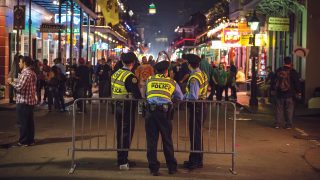
A series of critical incidents in the 1960s served as catalysts in the development of police psychology as a specialty. The March 1963 kidnapping of two LAPD officers (aka “the onion field”) highlighted the need for officers to be able to talk through tough feelings (e.g., grief, shame, guilt) professionally and receive addiction treatment and suicide prevention services. The August 1965 CHP police chase of a young Black male (aka “the Watts riots”) highlighted the need for psychologists to train officers in community relations, crowd control and interpersonal skills to positively impact police–community relations. The August 1966 off-duty officer-involved shooting at the University of Texas at Austin’s Main Building (aka “the tower shooting”) highlighted the need for psychological services to be available for off-duty law enforcement personnel through their employing agency.
The officer experienced survivor guilt, PTSD and crushing bouts of depression.
The onion field
The critical incident. March 9, 1963. 2200 hours. Traffic stop. Corner of Carlos Avenue and Gower Street in Hollywood. LAPD officers (and former U.S. Marines) Ian Campbell and Karl Hettinger pulled over a 1946 Ford Coupe for an illegal U-turn.
The suspects had their guns ready when the officers approached and ordered the driver out of the vehicle. The driver exited, pointed a gun at Officer Campbell’s head, and threatened to kill him. Officer Campbell told his partner to “give him your gun,” and Officer Hettinger did so. Both officers were then forced into the suspects’ vehicle; they were abducted within 30 seconds of initiating the traffic stop. The suspects drove the officers about 100 miles to an onion field in Bakersfield, California. The driver executed Officer Campbell in the onion field. Officer Hettinger escaped on foot through the onion field, ran almost four miles across irrigated fields to reach a farmhouse, and called for help.
Aftermath. The driver was arrested by CHP the same night. The accomplice was arrested the next day in Bakersfield. Bagpipes were played at Officer Campbell’s funeral service. Officer Hettinger was severely traumatized by the critical incident as well as his treatment afterward (e.g., he was paraded in front of roll calls and humiliated for his actions, and the department created a training video showing what not to do based on his actions during the critical incident). The officer experienced survivor guilt, PTSD and crushing bouts of depression. He consumed alcohol to cope, was suicidal, shoplifted and was forced to resign from the LAPD in 1966.
Lessons learned. Never voluntarily give up your gun. Carry a backup gun. Always know where you are. Traffic stop policies needed revision. Officers needed to be trained in kidnap procedures and post-critical incident trauma, and they deserve support after critical incidents. Do not shame officers in roll-call trainings. Alcohol does not make problems go away. Reach out and support officers who are suffering; do not leave them flapping in the wind by themselves.
Train officers in community relations, crowd control and interpersonal skills to more effectively work with the public.
Watts riots
The critical incident. August 11–16, 1965. Watts neighborhood of Los Angeles. The riots began after a 21-year-old Black male was pulled over for reckless driving in his mother’s 1955 Buick by a CHP motor cop. The suspect failed the sobriety tests, resisted arrest and, while a crowd of about 1,500 local residents gathered, was struck in the face with a baton. Rioting immediately began and swelled across 46 square city miles (including other adjacent cities) and continued for days due to anger over racism and abusive policing as well as the impact of systemic racism on the community. A neighborhood curfew and mass arrests were ordered. The widespread rioting (including looting, arsons, physical assaults and property damage) was met with a paramilitary and military response; the governor ordered more than 10,000 California National Guard troops, 2,000 active soldiers and 1,500 Marines on-scene to support the 5,000 LAPD officers.
Aftermath. Dr. Martin Luther King Jr. arrived in Los Angeles on August 17, addressed the citizens regarding the riots, said that “violence is not the answer to social conflict,” particularly “in light of the tremendous nonviolent sacrifices” that others have endured, that everyone must accept their share of the responsibility in the damage done to the city, but that it also remains important to “right the wrongs” that initially fueled such violence. He said that there was a need for everyone to get to work and “to heal a broken community.” The McCone Commission, which was enacted by the governor to investigate the riots, identified the root causes of the riots and provided recommendations (including police–community ties) in a 101-page report.
Lessons learned. Attend to police–community relationships. Address systemic racism and socioeconomic disparities. Create meaningful systemic police
reform. Train officers in community relations, crowd control and interpersonal skills to more effectively work with the public.
The tower shooting
The critical incident. August 1, 1966. 1148–1324 hours. Active shooter. A mentally ill former U.S. Marine sharpshooter was positioned at the top of the University of Texas Main Building (known as “the tower”) and was shooting random individuals and first responders. He had multiple rifles, a sawed-off shotgun and other firearms.
Austin P.D. Officer Ramiro Martinez (a former U.S. Army combat medic) was off-duty when he learned of what was unfolding on the news in real time. He called into work to offer assistance and was told to assist with traffic. Martinez deployed on-scene to discover that traffic was already covered and saw the carnage of bodies, so he decided to make a run for the tower without waiting for other officers (as it had been over an hour of shooting and no one had reached the observation deck yet). He began to zig-zag across the lawn to avoid being hit and felt very “lonely” in what he had to do. He took the elevator up to the 26th floor while continuing to hear shots fired, said his Act of Contrition prayer because he thought he might die and saw Austin P.D. Officer Jerry Day and civilian volunteer Allen Crum (who was a retired Air Force tail gunner) as he exited the elevator. Martinez moved upstairs one floor with Crum to the shooter’s position, deputized Crum on the spot, convened with Houston P.D. Officers Day and McCoy, and initiated a gunfight with the suspect. Officers Martinez and McCoy fatally shot the suspect.
Aftermath. The autopsy found a brain tumor believed to contribute
to the suspect’s homicidality and suicidality. The officer was criticized for going to the observation deck without waiting for backup; the officer continued to maintain he did the right thing. The public outcry over the massacre resulted in the creation of a cohesive university police department trained to combat all threats on campus.
Lessons learned. The need for active shooter protocols (including confronting an active shooter as soon as possible to limit casualties), a centralized command post to direct operations, a clearly designated OIC on-site, a plan with a unified law enforcement response, ongoing police leadership and communication during critical incidents, and the need for psychological support services to be available for off-duty law enforcement personnel through their employing agency.
Key takeaways
The onion field, Watts riots and the tower shooting are major critical incidents during the 1960s, which helped catalyze police psychology as a professional specialty. They highlighted the need for officers to be trained in post critical incident trauma, community relations, crowd control and interpersonal skills to positively impact police–community relations. They also highlighted the need for officers, including those who respond off duty, to receive psychological support through their employing agency. Officers deserve such training and support. Stay safe.
As seen in the February 2025 issue of American Police Beat magazine.
Don’t miss out on another issue today! Click below:





